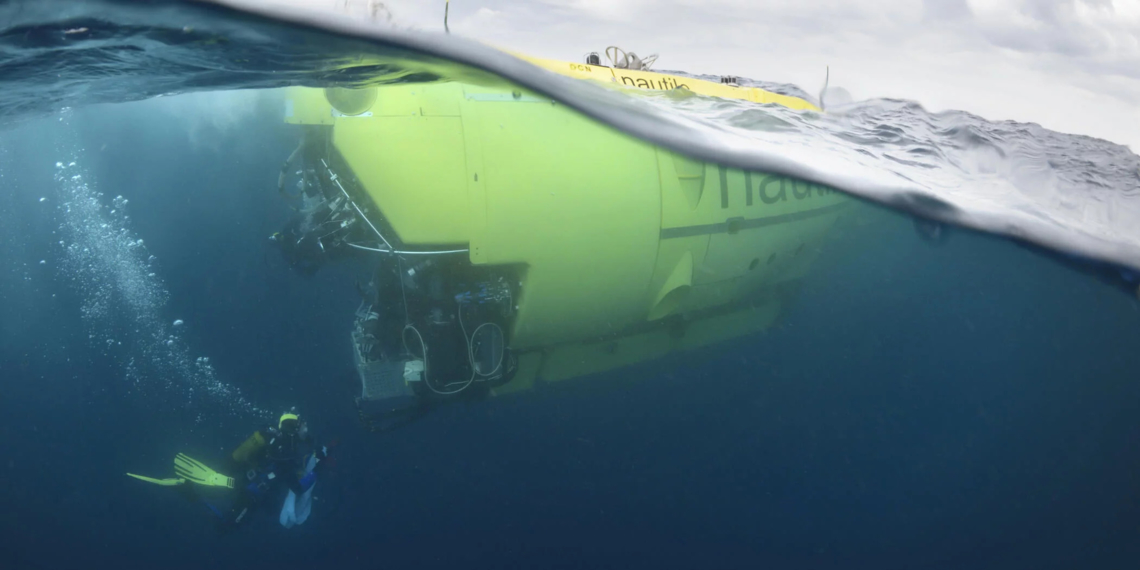Exploration of the abysses: a second life for the Nautile
Built in partnership with the Direction Générale de l'Armement (DGA) and the Direction des Constructions et Armes Navales (DCAN), the Nautile submersible was commissioned in 1984. Since then, it has been exploring the abyss at depths of up to 6,000 meters: for six to eight hours per dive, a scientist and two pilots observe the seabed and conduct experiments from the submarine's sphere. Today, only five countries in the world - the USA, Japan, China, Russia and France - have a submarine with such capabilities.
A highly strategic capability for the world's second-largest maritime nation
Covering around two-thirds of the earth's surface, the ocean - the planet's largest ecosystem - is still largely unknown, and holds great potential for scientific discovery. Deep-sea exploration has become a highly strategic priority, and is one of the main thrusts of the France 2030 plan. While this plan emphasizes robotization (autonomous high-capacity or swarm vehicles, vehicles remotely operated from the surface, cabled networks for measurement or detection), deep-sea manned diving stands out for its ability to enable human presence in the abyss. This capability requires special expertise, and France is the only country in the European Union to design, maintain and operate a manned submarine capable of diving to a depth of 6,000 meters.
France renews its deep-sea diving capability
After analyzing the advantages and constraints of deep-sea manned diving, and studying the international context of marine science and technology research, the focus has shifted to deep-sea robots. Currently undergoing modernization, the Victor 6000 underwater vehicle is operated by cable from the surface: it boasts complementary capabilities to those of the Nautile and will soon incorporate new sensors and in situ sampling and analysis tools to collect even more scientific data than it does today. The latest addition to the French oceanographic fleet, the Ulyx autonomous robot, is dedicated to mapping and inspecting the seabed at depths of up to 6,000 meters. Developed between 2016 and 2022, it is currently in the technical and operational validation phase.
It was against this backdrop that the steering committee of the French oceanographic fleet decided in 2018 to eventually replace the Nautile with a second remotely operated underwater vehicle (ROV) by 2025.
However, the shutdown of the Nautile meant the non-renewal of rare technical and operational skills, as well as the loss of an entire body of expertise. These are strategic issues to which the French government, through the France 2030 plan, is sensitive, as they involve national sovereignty. The decision to maintain a deep-sea diving capability and associated skills until 2035 was therefore announced by French President Emmanuel Macron on December 12, 2023.
Technological advances and unique expertise
Through the France 2030 plan, France aims to develop a world-class industrial sector in underwater technologies, products and services, and to maintain its strategic capacity to maintain a human presence in the deep sea.
The Nautile, like its companions Victor 6000 and Ulyx, stands out for its many scientific instruments and functions, making it a major asset for exploration. In particular, it offers a direct perception of the underwater environment and navigates with great flexibility. From an operational point of view, the use of a manned craft in association with an autonomous underwater vehicle (AUV) enables more efficient exploration of the deep sea. The Nautile is deployed from the French oceanographic fleet's offshore vessels: L'Atalante (84 meters) and the Pourquoi pas ? (107 meters).
Within the framework of France 2030, the project will reflect the technological achievements of French research and industry, and will bring together specialist companies to maintain France's deep-sea diving capability, while adapting it to the challenges of the next decade. Le Nautile's continued operation has been made possible thanks to €33 million in funding from the Secrétariat Général pour l'Investissement (SGPI) via the Agence Nationale de la Recherche (ANR).
Nautile identity card
- Inside sphere diameter: 2.10 m
- 3 large-view portholes and 10 LED spotlights (direct vision up to 15 m away)
- A sonar that detects objects or obstacles over a 300 m radius
- 2 manipulator arms
- High-definition video sensors
- A normal indoor atmosphere in terms of pressure and chemical composition
- Material: titanium alloy
- Autonomy (bottom work) at 6000 m: 6 h
- Maximum dive time: 11 h
- Range: 10 km
- Scientific equipment carrying capacity: 200 kg or 600 liters
A window on the deep
Since the 19th century, the mysterious world of the abyss has been approached step by step. Whether it's the in situ demonstration of plate tectonics, underwater avalanches, the hazards associated with deep earthquakes, or hydrothermal springs, veritable oases of life, the advances in understanding the workings of the oceans and their ecosystems have been remarkable since the 1970s, thanks to advances in technology. The Nautile submersible remains one of the major players in these explorations. It is one of the world's smallest deep-sea manned submarines:
- the Alvin submarine (USA), commissioned in 1964, maximum immersion at 6,500 meters
- the Shinkai submarine (Japan), commissioned in 1989, maximum immersion 6500 meters
- the two MIR submarines (Russia), commissioned in 1987, maximum immersion 6000 meters
- the Jiaolong submarine (China), commissioned in 2010, maximum immersion at 7,000 meters
About the French Oceanographic Fleet, by Ifremer
The French Oceanographic Fleet criss-crosses the world's seas to better understand and protect the ocean, from coast to coast, and from the surface to the depths. This major research infrastructure (IR* accredited by the French Ministry of Research) addresses today's major challenges in marine science and technology.
With seventeen vessels and six submarines, it is open to the French and European scientific community, and contributes to the excellence of fundamental and applied research. It also carries out surveillance and public service missions on behalf of the French government, and its teams are called upon to work in partnership with companies. Operated by Ifremer and its armament subsidiary Genavir, it is one of the five largest scientific fleets in the world.
Further information: https://www.ifremer.fr/fr/flotte-oceanographique-francaise
Discover the film of the French Oceanographic Fleet here
About the France 2030 investment plan
- It reflects a dual ambition: to transform key sectors of our economy (healthcare, energy, automotive, aeronautics and space) through technological innovation, and to position France not just as a player, but as a leader in the world of tomorrow. From fundamental research, to the emergence of an idea, to the production of a new product or service, France 2030 supports the entire life cycle of innovation, right through to industrialization.
- is unprecedented in its scale: €54 billion will be invested to help our companies, universities and research organizations make the transition in these strategic sectors a success. The aim is to enable them to respond competitively to the ecological and attractiveness challenges of the world ahead, and to create the future leaders of our sectors of excellence. France 2030 is defined by two cross-functional objectives: to devote 50% of its spending to decarbonizing the economy, and 50% to emerging, innovative players, with no expenditure detrimental to the environment (in line with the Do No Significant Harm principle).
- Is implemented collectively: designed and deployed in consultation with economic, academic, local and European players to determine its strategic orientations and flagship actions. Project leaders are invited to submit their applications via open, demanding and selective procedures, in order to benefit from government support.
- Managed by the Secrétariat Général pour l'Investissement on behalf of the Prime Minister, and implemented by the Agence de la Transition Ecologique (ADEME), the Agence Nationale de la Recherche (ANR), Bpifrance and the Banque des Territoires.
For more information: france2030.gouv.fr | @SGPI_avenir
About Agence nationale de la recherche
The Agence Nationale de la Recherche (ANR) is France's funding agency for project-based research.
The ANR is a public institution under the authority of the French Ministry of Higher Education and Research, whose mission is to support and promote the development of fundamental and applied research in all disciplines at national, European and international levels. It also funds technical innovation and technology transfer, partnerships between public and private sector research teams, and reinforces the dialogue between science and society.
ANR is also the main operator of the France 2030 plan for higher education and research. France 2030 supports excellence and transformations in higher education, research, training and innovation in priority sectors. The agency selects, finances and monitors projects in line with these objectives.
ANR is ISO 9001 certified and has been awarded the "professional equality" label.
Further information: anr.fr | @agencerecherche


